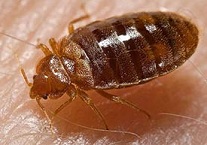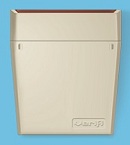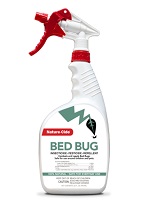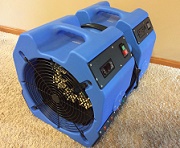 NATIONAL REPORT—Dig into The Bedbug Registry a bit and you just might find your own hotel listed as a place where travelers encountered bedbugs. In this social media age, where a bedbug report can go viral in seconds, it makes sense to take the necessary steps—hopefully eco-friendly ones—to keep bedbugs out and, if necessary, kill them effectively. Fortunately for those concerned about the safety of their guests and staff, there are a wide range of environmentally safe products available to detect, protect against, and kill bedbugs.
NATIONAL REPORT—Dig into The Bedbug Registry a bit and you just might find your own hotel listed as a place where travelers encountered bedbugs. In this social media age, where a bedbug report can go viral in seconds, it makes sense to take the necessary steps—hopefully eco-friendly ones—to keep bedbugs out and, if necessary, kill them effectively. Fortunately for those concerned about the safety of their guests and staff, there are a wide range of environmentally safe products available to detect, protect against, and kill bedbugs.
It makes sense to utilize greener approaches because bedbugs have an incredible ability to develop resistance to synthetic pesticides and they can develop that resistance in a short period of time, says Paul Curtis, BCE, Manager, Technical Services, Terminix International. Also, Curtis adds, the number of incidences of bedbug infestations continues to increase. “They have not decreased at all,” Curtis says. “Bedbugs are very good hitchhikers.”
Identifying a bedbug infestation before your guests find out about them is critical. BedBug Central offers a SenSci ActivVolcano Bed Bug Detection Kit. According to the company, an attractant lures the bugs into a trap from which they cannot escape. The lure mimics chemicals found on the skin to attract bed bugs. The detection kit fits discreetly in a guestroom.
Carbon Dioxide as an Attractant
FMC Corp. offers a Verifi bed bug detector. It is a small detection device that operates silently. Inside the detector is a CO2 booster pack that mimics a living, breathing host for about 24 hours using a chemical reaction to generate carbon dioxide. This reaction starts upon activation and requires no batteries or other power source, allowing for discreet placement and operation. The replaceable Verifi lure features two additional attractants: a kairomone that attracts bedbugs seeking a meal, and a pheromone that encourages bedbugs to gather together in the harborage area of the device. These attractants are continuously emitted for up to 90 days.
 AP & G Co., Inc. offers two bedbug detection products—Slider and BDS2.0. Bedbugs explore the textured base of the Slider while entering from all four sides. Bedbugs are then trapped on the adhesive and easily detected through the clear window. The strong plastic design allows for use under mattresses. Utilizing certain key materials and other patented technology, BDS2.0 monitors create a harborage so bedbugs can be detected before they proliferate and infest a new location.
AP & G Co., Inc. offers two bedbug detection products—Slider and BDS2.0. Bedbugs explore the textured base of the Slider while entering from all four sides. Bedbugs are then trapped on the adhesive and easily detected through the clear window. The strong plastic design allows for use under mattresses. Utilizing certain key materials and other patented technology, BDS2.0 monitors create a harborage so bedbugs can be detected before they proliferate and infest a new location.
BioSensory, Inc.’s NightWatch Bedbug Monitor mimics a living, breathing human body—combining CO2 and a thermal heat source for a two-pronged attractant and trapping system. When bedbugs approach to feed on what they think is a human, they fall into the pitfall traps made of highly polished material and cannot escape. NightWatch can catch both mature and immature bed bugs, and since the monitor’s detection period spans the seven to 10 days bedbugs take between meals, it can detect infestations the very first time they try to bite.
The Role of Mattress Encasements
According to Protect-A-Bed, mattress and box spring encasements are an effective way to proactively guard against bedbugs. If there already is an infestation, encasing the mattress and box spring will entomb the bedbugs and they will eventually die. (Of course one should remove or destroy as many eggs as possible before encasing the mattress and box spring.) This extends the life of the mattress and box spring, keeping them out of the landfill. Light-colored mattress and box spring encasements also make it easier to detect bedbugs when they are around.
 The Mallis Handbook of Pest Control recommends using encasements that have been designed specifically as bedbug management tools. Protect-A-Bed, for example, has designed an encasement with a BugLock and Secure Seal to keep bedbugs from using the zipper opening. The company’s encasements also feature double stitched seams. Micro-Zipper teeth are designed to prevent baby bedbugs from weaving through the teeth of the zipper. A Miracle Membrane creates a bedbug proof barrier on all six sides of the encasement.
The Mallis Handbook of Pest Control recommends using encasements that have been designed specifically as bedbug management tools. Protect-A-Bed, for example, has designed an encasement with a BugLock and Secure Seal to keep bedbugs from using the zipper opening. The company’s encasements also feature double stitched seams. Micro-Zipper teeth are designed to prevent baby bedbugs from weaving through the teeth of the zipper. A Miracle Membrane creates a bedbug proof barrier on all six sides of the encasement.
If you already have an infestation or would like to prevent one, there are numerous spray products on the market that use natural ingredients. Often those ingredients are derived from plants. Minimum risk pesticides that meet certain criteria are exempt from federal registration under section 25(b) of the Federal Insecticide, Fungicide, and Rodenticide Act (FIFRA). The U.S. Environmental Protection Agency (EPA) does not review or register pesticides that satisfy the 25(b) criteria, though registration is required by most states.
“There are some that are not good at all or effective or moderately effective,” Terminix’s Curtis says. He adds that to kill a bedbug with many of these products you need to make a topical application. The challenge, he says, is that it is not often that you can apply product directly on a bedbug.
Two-Week Residual Effect
According to Todd Zhong, V.P. of Operations for Reneotech, Inc., maker of EcoRaider, the spray product is natural but “performs as well or better than synthetic pesticides.” “You can use the product at any time,” Zhong says. “It is effective on other crawling insects as well.” EcoRaider, made from organically extracted botanical insecticidal compounds, has a 14-day residual effect, meaning it will continue to kill bedbugs up to two weeks after application.
Bed-Bug-Rid, from Iguana Rid, LLC, “is safe to spray on, safe to lay on,” according to Rob Streisfeld, a natural products consultant for Iguana Rid. “We use cinnamon bark oil as a main ingredient.” The product also has food grade diatomaceous earth in it. “You can use it preventively and during an infestation,” Streisfeld says.
 EES, Inc.’s BugBand spray is a natural plant-based product made from the oil of geraniums—geraniol, according to Ben Longley, Category Manager for EES. “It is very safe to use,” Longley says. “All bedbugs have an exoskeleton. When our product comes in contact with the bedbug’s body, it melts the exoskeleton. Geraniol is also an insect repellant. Once we treat a room it repels them from coming back.” BugBand has a residual effect of about two to three days.
EES, Inc.’s BugBand spray is a natural plant-based product made from the oil of geraniums—geraniol, according to Ben Longley, Category Manager for EES. “It is very safe to use,” Longley says. “All bedbugs have an exoskeleton. When our product comes in contact with the bedbug’s body, it melts the exoskeleton. Geraniol is also an insect repellant. Once we treat a room it repels them from coming back.” BugBand has a residual effect of about two to three days.
Bed Bug Fix from Eco Hygienics, according to John Barton, Marketing Directory, is an all-natural product made from a variety of natural oils. “It has a 30-day residual effect,” he says. “It is very economical. It is not a pesticide so you don’t need a license to apply it.” Bed Bug Fix kills adults, larvae and eggs.
Matthew Mills, founder and CEO of Nature-Cide All-Natural Pesticides and Insecticides, says Nature-Cide is 100 percent natural, does not have a heavy aroma, and includes a light clove and cottonseed oil mixed with a soap mixture. “Nature-Cide sticks to the exoskeleton and causes a breathing and neurological disorder, killing the bug almost instantly,” Mills says. “You can spray all the time. It does have a residual effect but it is designed to be used daily. You can treat a room from top to bottom. The guest can be in the room immediately.”
Too Hot for Bedbug Comfort
Heat can also be one effective tool in a bedbug killing arsenal, as long as the right equipment, temperature and technique are used. “Our system is built for hotel rooms,” says Jeff Zimmerman, owner, Bed Bug Heat Doctor. “It can be used for preventive maintenance and for service to take care of the problem. The longer you have it in the room, the better. If you pump a high temperature for a short period of time, you may push the insects into another room. We heat up slowly. We recommend three fans and a heater for every room. Our fans are high-temperature heaters. A box fan would not work. The bearings would break down quickly.”
Zimmerman says heat kills all stages of bedbugs. “You want to hold 132 degrees for at least four hours to affect the wall,” he says. “Ninety percent will not be in the wall or other rooms. They will be within five feet of the headboard. You have to have an infestation for more than a year to be in the wallboard. They are not very strong bugs. They don’t hold onto surfaces very well.”
 Bed Bug Heat Doctor is seeing more problems with bedbugs that have not been affected before. Areas that had been hard hit are still seeing problems. “We are getting more and more hoteliers because chemicals have failed or they don’t want to expose guests to chemicals,” Zimmerman says. “Bedbugs are well adapted to chemicals. They can’t become immune to heat.” While using heat can initially cost more than other treatment methods, Zimmerman says it does not take many treatments to pay for a system—sometimes just a few rooms.
Bed Bug Heat Doctor is seeing more problems with bedbugs that have not been affected before. Areas that had been hard hit are still seeing problems. “We are getting more and more hoteliers because chemicals have failed or they don’t want to expose guests to chemicals,” Zimmerman says. “Bedbugs are well adapted to chemicals. They can’t become immune to heat.” While using heat can initially cost more than other treatment methods, Zimmerman says it does not take many treatments to pay for a system—sometimes just a few rooms.
According to Terminix’s Curtis, bedbugs will die beginning at 113 degrees. Heat should be used with caution, he says, as you do not want to trigger the sprinkler system.
Another type of heat treatment is steam heat. Alex Enos, a sales representative with Daimer Industries, maker of steam cleaners for bedbug removal, recommends using a vapor steam cleaner on high. “We suggest you go along the mattress seams and in and around the tag as well. For a general surface treatment we have a large angled tool. You place a microfiber cloth over it. You turn the cleaner on full and run the tool over the mattress.”
“Steaming is not good for all applications but you can use it on mattresses and box spring surfaces,” adds Terminix’s Curtis. “You don’t want to get things too wet. Some materials can shrink.”
The other end of the treatment spectrum to heat is freezing. According to Terminix’s Curtis, whose company offers a RapidFreeze solution, carbon dioxide is applied. “It creates dry ice snow at a temperature of minus 100 degrees,” he says. “It can get in cracks and crevasses. It provides an immediate mortality. It does not leave a residual. You can treat different parts of the mattress—the surface of the mattress, the headboard. You can treat electronics. It is a surface treatment.”
Inspect Adjacent Rooms
Experts agree that the best way to eradicate or control bedbugs is to employ multiple methods. While bedbugs can develop resistance to chemicals, they cannot develop resistance to something as simple as vacuuming, heat or below freezing cold. Terminix’s Curtis, a Board Certified Entomologist, says it is always important to at least inspect any room connected to the problem room as bedbugs might actually be harboring in an adjacent room.
“Twenty-five percent of the time, if you have an infestation in one room, you will find it in a connected room,” Curtis says. “Look at above and below as well. They follow plumbing, electric lines, cable.”
Finding companies that utilize nontoxic approaches to bedbug elimination is not difficult. “Most responsible companies use natural processes because they are effective,” Curtis says. Before purchasing any type of spray-on or dust product, be sure to ask the supplier if the product has been third party tested by a reputable organization. Also be sure to ask for proof of product safety.
Click here for additional information on bedbugs.
Glenn Hasek can be reached at editor@greenlodgingnews.com.





